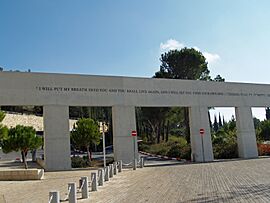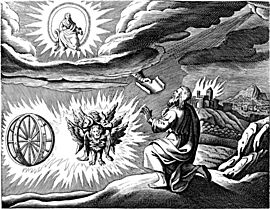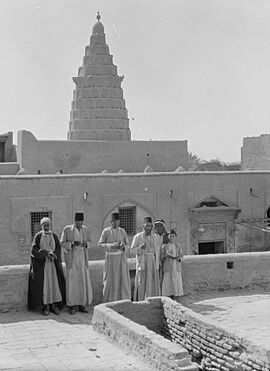Ezekiel facts for kids
Quick facts for kids Ezekielיְחֶזְקֵאל |
|
|---|---|
| Prophet and Priest | |
| Born | Possibly c. 623 BCE Jerusalem, Kingdom of Judah |
| Died | After c. 571 BCE Babylon, Neo-Babylonian Empire |
| Venerated in | |
| Major shrine | Ezekiel's Tomb, Iraq |
| Feast |
|
| Controversy | Babylonian captivity |
Ezekiel, also known as Ezechiel, was an important Israelite priest and prophet. His name means "God is strong" or "God strengthens" in Hebrew. The Book of Ezekiel in the Bible tells us about his amazing visions and what he did.
Ezekiel is recognized as a prophet in major religions like Judaism, Christianity, and Islam. He lived during a tough time for the Jewish people, known as the Babylonian captivity. He prophesied that Jerusalem, the capital city of Judah, would be destroyed. After the Babylonians attacked Jerusalem in 587 BCE, destroying Solomon's Temple, Ezekiel also shared messages of hope. He foretold that the Jewish people would eventually return to their homeland, the Land of Israel.
It is thought that Ezekiel died around 570 BCE. His tomb, Ezekiel's Tomb, in Iraq, is a very important religious site for Jewish people. About three decades after his death, the Babylonian captivity ended. This happened when the Persians conquered Babylon in 539 BCE. The Jewish people were then allowed to return to Zion, their homeland, thanks to a decree from the Persian king Cyrus the Great.
Contents
Ezekiel's Story in the Bible
The Book of Ezekiel begins with Ezekiel introducing himself as the son of Buzi. He was from a family of priests. The book tells us that his first divine encounter happened "in the thirtieth year." Ezekiel describes in great detail how he was called to be a prophet. He tells of seeing God and four "living creatures" with four wheels that moved alongside them.
The Bible says that Ezekiel and his wife lived during the Babylonian captivity. They were on the banks of the Kebar Canal in Tel Abib, near Nippur. They lived there with other people who had been exiled from the Kingdom of Judah. The Bible does not mention Ezekiel having any children.
A Timeline of Ezekiel's Prophecies
Ezekiel's "thirtieth year" is described as the fifth year that Judah's king, Jeconiah, was exiled by the Neo-Babylonian Empire. This means his prophecies started around 593 BCE. His last recorded prophecy is from April 571 BCE. This was sixteen years after Jerusalem was destroyed in 587 BCE. Based on the dates in the Book of Ezekiel, his prophecies happened over about 22 years.
Some ancient Jewish writings, like the Seder Olam Rabba, suggest that Ezekiel's vision came "in the thirtieth year after Josiah found a Book of the Law in the Temple." This event happened around 622 BCE, shortly after the prophet Jeremiah began his work around 626 BCE. If "thirtieth year" means Ezekiel's age, then he was born around 622 BCE. This would mean he was fifty years old when he had his final vision.
Other Stories About Ezekiel
Jewish Traditions
According to Jewish tradition, Ezekiel himself did not write the entire Book of Ezekiel. Instead, his prophecies were gathered and written down by a group called the Great Assembly.
Jewish texts like the Talmud and Midrash say that Ezekiel, like Jeremiah, was a descendant of Joshua through Joshua's marriage to Rahab. Some stories even say that Ezekiel was the son of Jeremiah. Jeremiah was sometimes called "Buzi" because some people looked down on him.
The historian Josephus wrote that Ezekiel was already a prophet in the Land of Israel. He continued to have this gift even after he was exiled to Babylon with King Jehoiachin and other important people in 598 BCE.
There is a story in the Babylonian Talmud by Rava. It says that Ezekiel described God's throne (merkabah) in great detail. This wasn't because he saw more than the prophet Isaiah. It was because Isaiah was more used to such visions. Rava compared it to a royal courtier and a farmer. The farmer would describe a royal court more grandly than the courtier, who sees it every day. Ezekiel, like all prophets, saw only a blurry reflection of God's majesty. It was like looking into a mirror that doesn't show things perfectly.
Another Jewish story, from the midrash Shir HaShirim Rabbah, tells us that Ezekiel was asked for advice. Three religious men, Hananiah, Mishael, and Azariah (also known as Shadrach, Meshach, and Abednego), asked him if they should obey King Nebuchadnezzar. The king wanted them to worship his idol, or else they would be burned.
At first, God told Ezekiel that these men could not expect a miracle. Ezekiel was very sad because these three men were very important to the Jewish people. But after they left Ezekiel's house, determined to die for God, Ezekiel received a new message:
When they went out from before Ezekiel, the Holy One blessed be He revealed Himself and said: 'Ezekiel, what do you think, that I will not stand by them? I will certainly stand by them.' That is what is written: "So said the Lord God: Concerning this too, I will acquiesce to the house of Israel" (Ezekiel 36:37). 'But leave them and do not say anything to them. I will leave them to proceed unsuspecting.'
Christian Traditions
Ezekiel is honored as a saint in the Eastern Orthodox Church. His feast day is July 21. For churches using the traditional Julian Calendar, this falls on August 5 of the modern Gregorian Calendar. The Armenian Apostolic Church celebrates him on August 28. Some Lutheran churches also remember him on July 21.
Saint Bonaventure, a Christian scholar, thought Ezekiel's words about the "closed gate" were a prophecy about Jesus' birth. He believed the "gate" meant the Virgin Mary and the "prince" meant Jesus. This idea is part of some Christian prayers and hymns. It also led to the idea that God gave Mary to humanity as the "Gate of Heaven."
Islamic Traditions
Ezekiel (called Ḥazqiyāl in Arabic) is also recognized as a prophet in Islamic tradition. While his name isn't directly in the Quran, many Muslim scholars include him in lists of Islamic prophets.
The Quran mentions a prophet named Dhū al-Kifl. Some scholars believe Dhu al-Kifl is Ezekiel. An explorer named Carsten Niebuhr visited Al Kifl in Iraq. He said that Kifl was the Arabic name for Ezekiel. He also noted that Ezekiel's Tomb was there and that Jewish people visited it for pilgrimage. The name "Dhu al-Kifl" means "Possessor of the Double" or "Possessor of the Fold." Some Islamic scholars think Ezekiel's mission was similar to what is described for Dhu al-Kifl. During the exile, the Jewish kingdom was gone, and political life was impossible. Ezekiel helped build a spiritual foundation for his people.
Regardless of whether Dhu al-Kifl is Ezekiel, Muslims see Ezekiel as a prophet. He appears in many collections of Stories of the Prophets. Muslim writings also say Ezekiel's father was Buzi (Budhi). Ezekiel is sometimes called ibn al-‘ajūz, meaning "son of the old (man)." This is because his parents were thought to be very old when he was born. A story, similar to Hannah and Samuel in the Hebrew Bible, says Ezekiel's mother prayed to God for a child in her old age and was given Ezekiel as a gift.
Where Ezekiel is Buried
Ezekiel's Tomb in Iraq
Ezekiel's Tomb is located in Al Kifl, Iraq, near Babylon. This place was historically very important to Jewish people. A mosque for Shia Muslims, the Al-Nukhailah Mosque, was built over it. After the Jewish exodus from Iraq in the 1950s, fewer Jewish people lived there. However, a disused synagogue still remains at the site. In 2020, there were reports that work was underway to turn the synagogue into a mosque.
Tomb in Ergani, Turkey
Another tomb in the Ergani District of Diyarbakır Province in Turkey is also believed to be Ezekiel's resting place. It is about 5 kilometers (3 miles) from the city center, on a hill. Local Muslims call it Makam Dağı and visit it with respect.
See also
- Apocryphon of Ezekiel
- Pseudo-Ezekiel
- List of names referring to El





